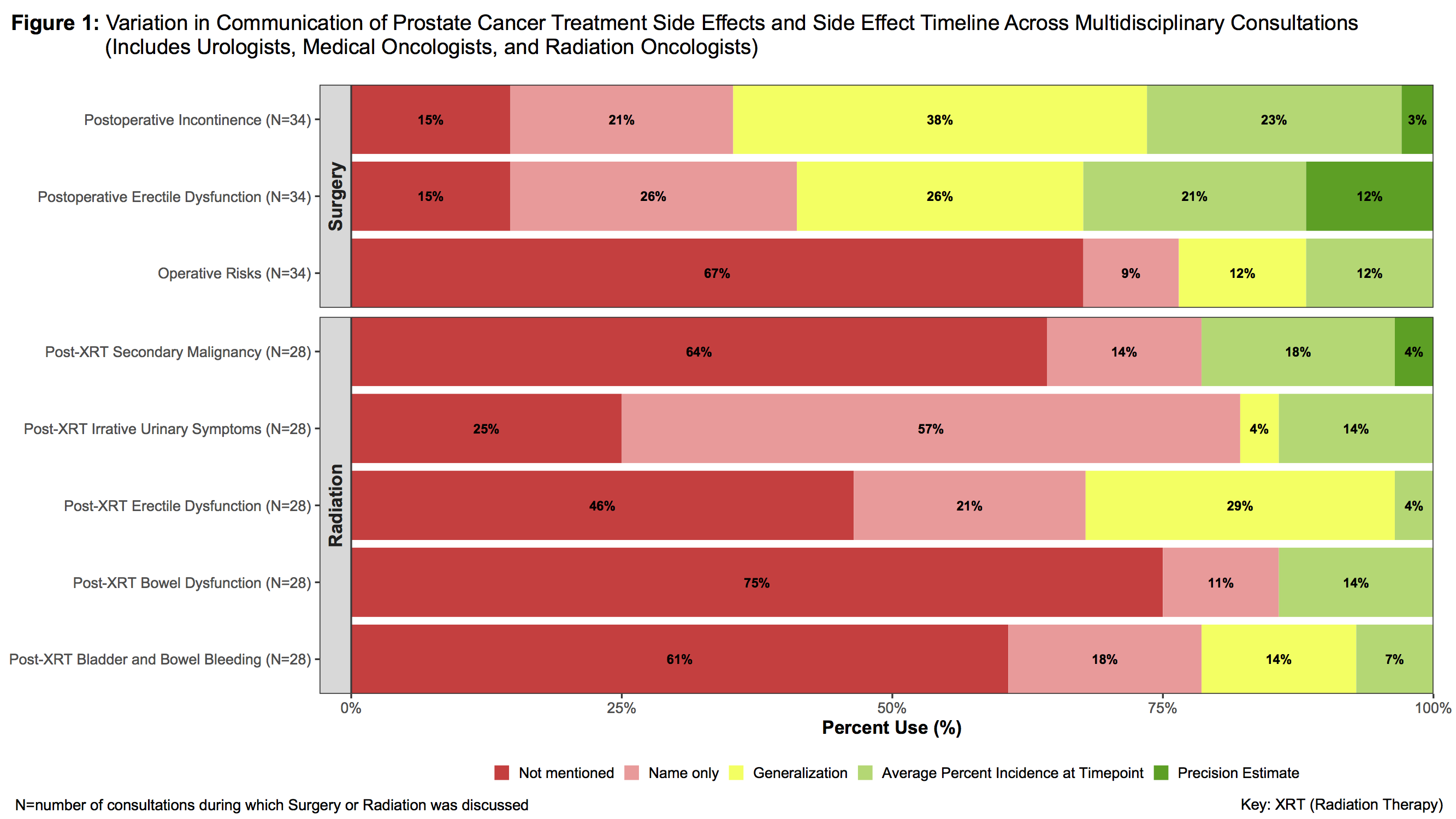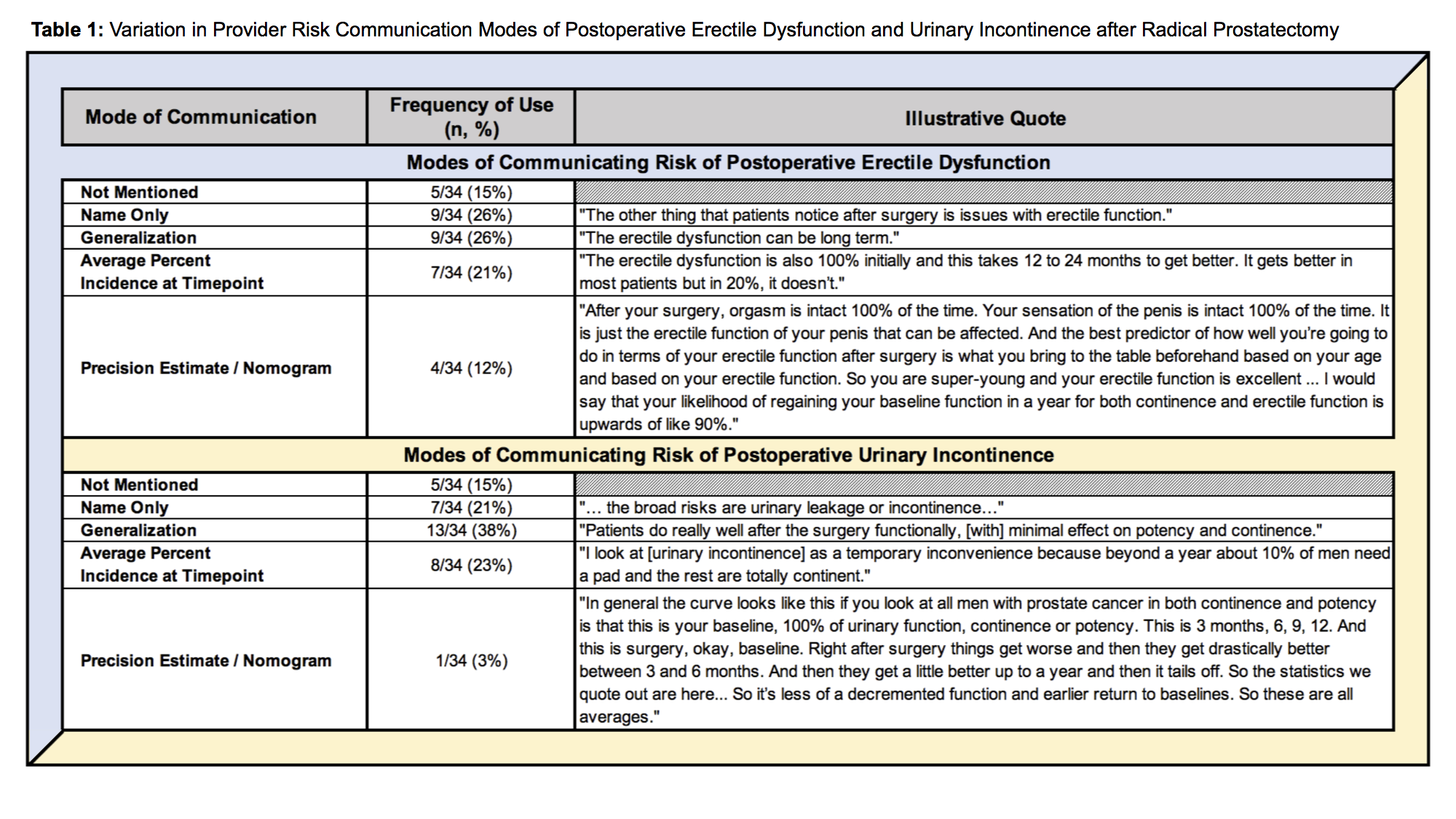Back
Poster, Podium & Video Sessions
Moderated Poster
MP31: Health Services Research: Quality Improvement & Patient Safety II
MP31-14: Variation in Communication of Side Effects in Prostate Cancer Treatment Consultations
Saturday, May 14, 2022
2:45 PM – 4:00 PM
Location: Room 228
Aurash Naser-Tavakolian*, Rebecca Gale, Michael Luu, Abhishek Venkataramana, Los Angeles, CA, Dmitry Khodyakov, Santa Monica, CA, Edwin Posadas, Howard Sandler, Jennifer Anger, Brennan Spiegel, Stephen Freedland, Timothy Daskivich, Los Angeles, CA

Aurash NaserTavakolian, MD
Cedars-Sinai Medical Center
Poster Presenter(s)
Introduction: Effective communication of treatment side effects is a key component of prostate cancer shared decision making. We qualitatively characterized how physicians communicate risk of side effects in treatment consultations.
Methods: We prospectively transcribed treatment consultations of 42 men with non-metastatic prostate cancer across 10 providers (4 urologists, 2 radiation oncologists, and 4 medical oncologists). Coders identified quotes related to side effects. Mode of risk communication was graded on a scale of increasing granularity: (1) name only (without risk quantification), (2) generalization (“high”), (3) average percent incidence at timepoint, and (4) precision estimate/nomogram. The most granular mode of risk communication used to describe each side effect throughout the consultation was reported.
Results: Among consultations discussing surgery, side effects mentioned included erectile dysfunction (ED) (29/34, 85%), incontinence (29/34, 85%), and operative risks (11/34, 32%). When mentioned, postoperative ED, incontinence, and operative risks were not quantified (mentioned by name only or generalization) in 18/29 (62%), 20/29 (69%), and 7/11(64%) of consultations, respectively. Illustrative quotes of varying risk communication are provided in Table 1. Among consultations discussing radiation, side effects mentioned included post-radiation ED (15/28, 54%), irritative urinary symptoms (LUTS) (21/28, 75%), secondary malignancy (10/28, 36%), bowel/bladder bleeding (11/28, 39%), and bowel dysfunction (7/28, 25%). When mentioned, post-radiation ED and irritative LUTS were not quantified in 14/15 (93%) and 17/21 (81%) of consultations, respectively. Risks of secondary malignancy, bowel/bladder bleeding, and bowel dysfunction were similarly often not quantified (all > 79%, Figure 1).
Conclusions: Side effects of prostate cancer treatment are often omitted or not quantified in treatment consultations. Physicians should articulate and quantify risks to optimize informed shared decision making.
Source of Funding: This work was supported by Career Development Award (K08 CA230155 to TJD) from the National Cancer Institute.


Methods: We prospectively transcribed treatment consultations of 42 men with non-metastatic prostate cancer across 10 providers (4 urologists, 2 radiation oncologists, and 4 medical oncologists). Coders identified quotes related to side effects. Mode of risk communication was graded on a scale of increasing granularity: (1) name only (without risk quantification), (2) generalization (“high”), (3) average percent incidence at timepoint, and (4) precision estimate/nomogram. The most granular mode of risk communication used to describe each side effect throughout the consultation was reported.
Results: Among consultations discussing surgery, side effects mentioned included erectile dysfunction (ED) (29/34, 85%), incontinence (29/34, 85%), and operative risks (11/34, 32%). When mentioned, postoperative ED, incontinence, and operative risks were not quantified (mentioned by name only or generalization) in 18/29 (62%), 20/29 (69%), and 7/11(64%) of consultations, respectively. Illustrative quotes of varying risk communication are provided in Table 1. Among consultations discussing radiation, side effects mentioned included post-radiation ED (15/28, 54%), irritative urinary symptoms (LUTS) (21/28, 75%), secondary malignancy (10/28, 36%), bowel/bladder bleeding (11/28, 39%), and bowel dysfunction (7/28, 25%). When mentioned, post-radiation ED and irritative LUTS were not quantified in 14/15 (93%) and 17/21 (81%) of consultations, respectively. Risks of secondary malignancy, bowel/bladder bleeding, and bowel dysfunction were similarly often not quantified (all > 79%, Figure 1).
Conclusions: Side effects of prostate cancer treatment are often omitted or not quantified in treatment consultations. Physicians should articulate and quantify risks to optimize informed shared decision making.
Source of Funding: This work was supported by Career Development Award (K08 CA230155 to TJD) from the National Cancer Institute.



.jpg)
.jpg)